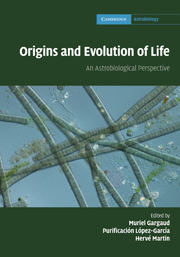Book contents
- Frontmatter
- Contents
- List of contributors
- Foreword
- Preface
- Part I What is life?
- Part II Astronomical and geophysical context of the emergence of life
- Part III The role of water in the emergence of life
- Part IV From non-living systems to life
- Part V Mechanisms for life evolution
- Part VI Life in extreme conditions
- Part VII Traces of life and biosignatures
- 25 Early life: nature, distribution and evolution
- 26 Early eukaryotes in Precambrian oceans
- 27 Biomineralization mechanisms
- 28 Limits of life and the biosphere: lessons from the detection of microorganisms in the deep sea and deep subsurface of the Earth
- Part VIII Life elsewhere?
- Index
27 - Biomineralization mechanisms
from Part VII - Traces of life and biosignatures
Published online by Cambridge University Press: 04 February 2011
- Frontmatter
- Contents
- List of contributors
- Foreword
- Preface
- Part I What is life?
- Part II Astronomical and geophysical context of the emergence of life
- Part III The role of water in the emergence of life
- Part IV From non-living systems to life
- Part V Mechanisms for life evolution
- Part VI Life in extreme conditions
- Part VII Traces of life and biosignatures
- 25 Early life: nature, distribution and evolution
- 26 Early eukaryotes in Precambrian oceans
- 27 Biomineralization mechanisms
- 28 Limits of life and the biosphere: lessons from the detection of microorganisms in the deep sea and deep subsurface of the Earth
- Part VIII Life elsewhere?
- Index
Summary
Introduction
Biomineralization is the process by which organisms form minerals; this is a widespread phenomenon and more than 60 minerals of biological origin have been identified up to now (e.g. Lowenstam, 1981; Baeuerlein, 2000; Weiner and Dove, 2003). Particular attention has been paid so far to eukaryotic biominerals, including the siliceous frustules of diatoms (e.g. Poulsen et al., 2003; Sumper and Brunner, 2008), the calcitic tests of foraminifers (e.g. Erez, 2003) and the aragonitic skeleton of modern scleractinian corals (e.g. Cuif and Dauphin, 2005; Meibom et al., 2008; Stolarski, 2003). However, prokaryotes can form minerals as well (Figure 27.1; Boquet et al., 1973; Krumbein, 1979). For instance, stromatolites are carbonate deposits that are usually interpreted as the result of bacterial biomineralization. Interestingly too, some bacteria, called ‘magnetotactic’, can produce intracellular magnetite crystals seemingly aimed at directing their displacements using the local magnetic field (Blakemore, 1982). While eukaryotes obviously synthesize minerals exhibiting very specific structures (although ascertaining quantitatively why it is obvious might be an issue), the biogenicity of prokaryotic biominerals is more difficult to infer. The morphology, the structure (e.g. crystallinity, presence/absence of defects) and the chemistry (including the isotopic composition) of these prokaryote biominerals have, however, frequently been proposed as potential biosignatures (e.g. Konhauser, 1998; Little et al., 2004). Such biosignatures have been used to infer the presence of traces of life not only in ancient terrestrial rocks but also in extraterrestrial rocks such as the Martian meteorite ALH 84001 (McKay et al., 1996).
- Type
- Chapter
- Information
- Origins and Evolution of LifeAn Astrobiological Perspective, pp. 450 - 468Publisher: Cambridge University PressPrint publication year: 2011
- 2
- Cited by



